Author: Elena Cué
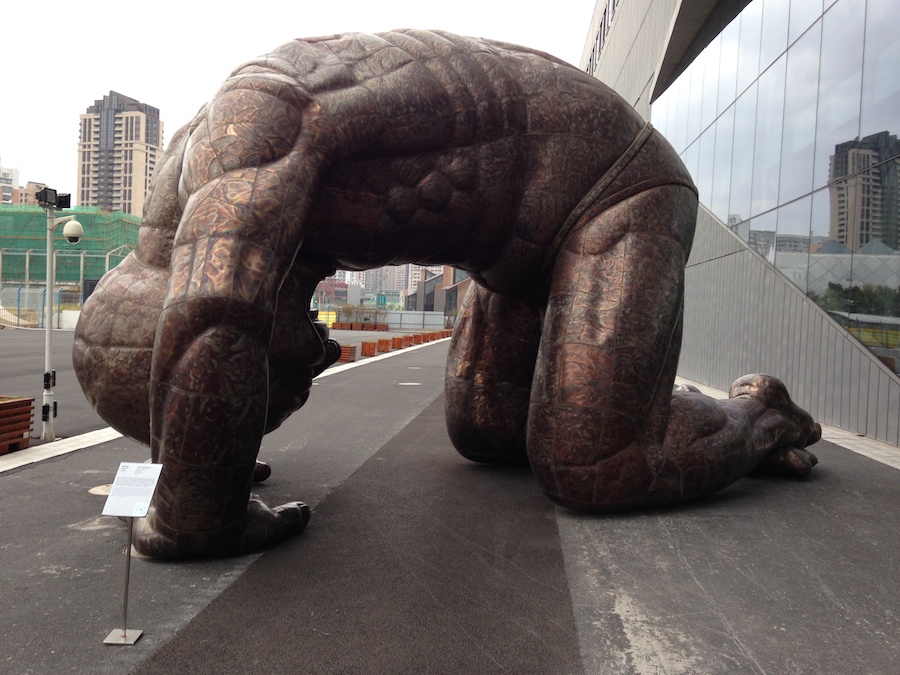
Yue Minjun (1962) is considered one of the most prominent Chinese artists of our time. He was born in the Heilongjiang province, situated in the North-East of China and belongs to a generation of artists who grew up in the midst of the the Great Proletarian Cultural Revolution (1966-1976). This was a decade marked by repression and fear, with education based on idealistic beliefs and principles. Intellectuals were sent to the countryside to work in order to learn about agriculture and production, contributing to the revolution through physical labour. With the death of Mao in 1976 came a period of reform and dramatically reduced repression, which saw an explosion of a new form of art. This emerged amidst many huge social, political and cultural changes, following an art form largely dictated by grandeur and political propaganda. The '80s are well-known for movements including '85 New Wave, which saw a surge of young artists breaking free from the recent past with a strong freedom of expression and creativity. The '90s, in turn, have been characterised by the emergence of Cynical Realism and Political Pop, and marked the beginning of the appearance of Chinese art internationally. Subsequently, the ‘noughties’ became a decade characterised by commercial success. Each of these factors have contributed to a transformation in the way of thinking and expressing art nowadays.
Elena Cué: Have these historical, largely outward changes been accompanied by similarly radical, internal changes for you?
Yue Minjun: Yes, that's right. My experiences, feelings and some things from my cultural past have been essential for my current artistic creation. Furthermore, these experiences have reaffirmed my artistic concepts. In general, the Chinese give the impression that we are calm and peaceful people, nothing eclectic or categorical.
E.C: How did the free art of your generation in the 80s and 90s errupt after the Maoist ruling?
Y.M: I started drawing at the age of 10, and, initially, during that learning process and the visual images of the time I was greatly affected in a different way to how I saw after the 80s. However, if you are an art lover, your interest will grow when you begin to understand why an artist paints in one way or another. Then, your interest grows into a deep curiosity and uses this as a tool to gain further knowledge, with a constant evolution towards personal growth.
Although a cultural and artistic system in China exists, with the introduction of foreign art the change was shocking.
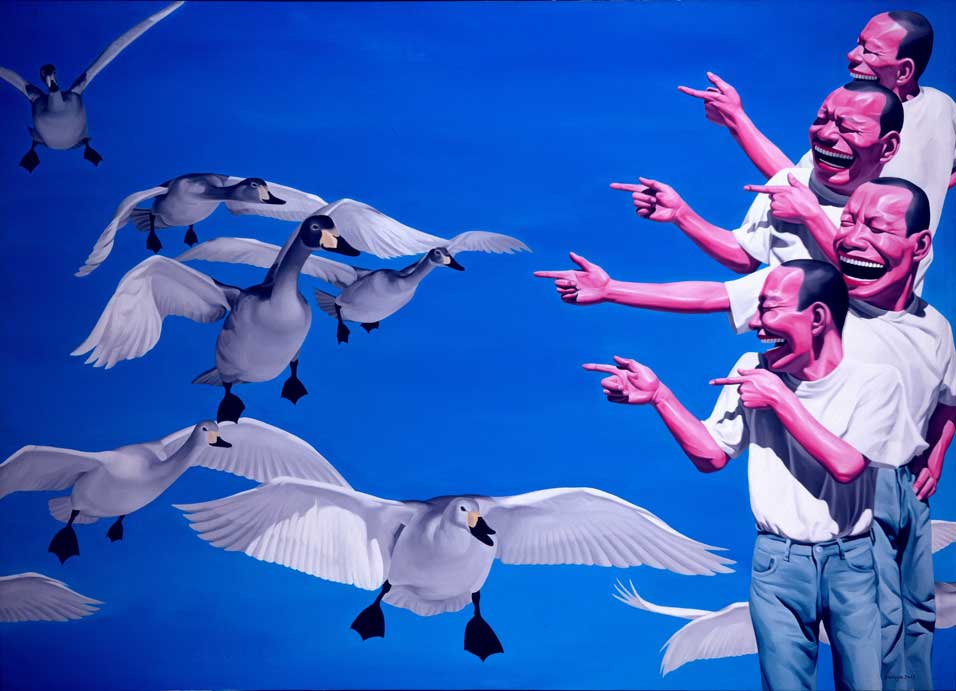
E.C: What memories do you have from your childhood and what has influenced you?
Y.M: Many things have influenced me, especially from a visual perspective, because what I perceived in those days - or what I remember from them - have been transmitted to my painting as one of the most important factors of expression.
In fact, in many of my works we can trace influences of the origin of propaganda painting, which emphasises the influence of the Cultural Revolution in my memory. For example, there are rows of heads that appear one after another, that undoubtedly offered transcendence in my past.
E.C: He has been considered to belong to the Cynical Realism movement, first described by the critic Li Xianting in the '90s. This came about in response to the tragic consequences of the student and intellectual protests in Tiananmen Square in 1989. These resulted in Minjun moving to a colony of artists in Hongmiao, situated in the Chaoyang district on the outskirts of Beijing. In 1989, an exhibition here by Chinese artist Geng Jinay, depicting his own face laughing, influenced Minjun’s work. And in 1993, Minjuin too began to use representative self images in his work - capturing himself in a frozen moment of laughter. These faces have since remained in all of his work, becoming an unmistakable sign and trademark of his artistic identity.
Joking, irony, mockery, humour and pleasure… Laughter manages to lighten tragedy and pain, acting like a remedy against helplessness; like a safeguard against the imposed cruelties of reality on the sanctity of life; a clarity within solemnity; acting to undo the natural urge for power, that is Nietzsche's concept of a will to power. Laughter acts as an antidote to our anxieties and concerns, as a symbol of protest… Laughter is a powerful tool encompassing many meanings.
What does laughter represent for you?
Y.M: In my work, laughter is a representation of a state of helplessness, lack of strength and participation, with the absence of our rights that society has imposed on us. In short, life. It makes you feel obsolete, which is why, sometimes, you only have laughter as a revolutionary weapon to fight against cultural and human indifference.
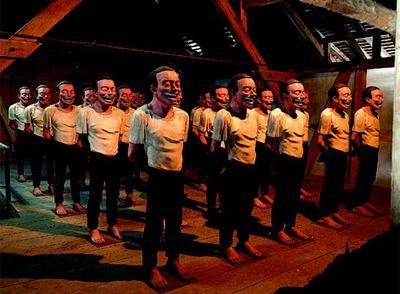
E.C: Minjun's international recognition came in 1999 when he was selected alongside other artists to be part of a show directed by Harald Szeemann for the 48th Venice Biennial. This saw a series of sculptures used in clear reference to the Terracotta Army of Qin Shihuang, the First Emperor of a United China; these are known as the warriors of Xian, with each of the warriors with a distinct face and identity. The individuals in your work are, by contrast, all smiling self-portraits.
Having grown up as part of a community, are you now using your work to try to empower the individual?
Y.M: Actually, the terracota army of Qin Shihuang Emperor, or The Warriors of Xi'an, are symbols representing feudalism. Then, the individuals are actually immersed within an expression of the army. Of course, if you look very closely, each one has a different expression; but if you reflect from a collective point of view, the image of each sculpture is projected more weakly.
Inspired by this historical work when I started to create my own sculptures, I trusted that using the same person and the same expression would portray the disappearance or absence of the individual more accurately.
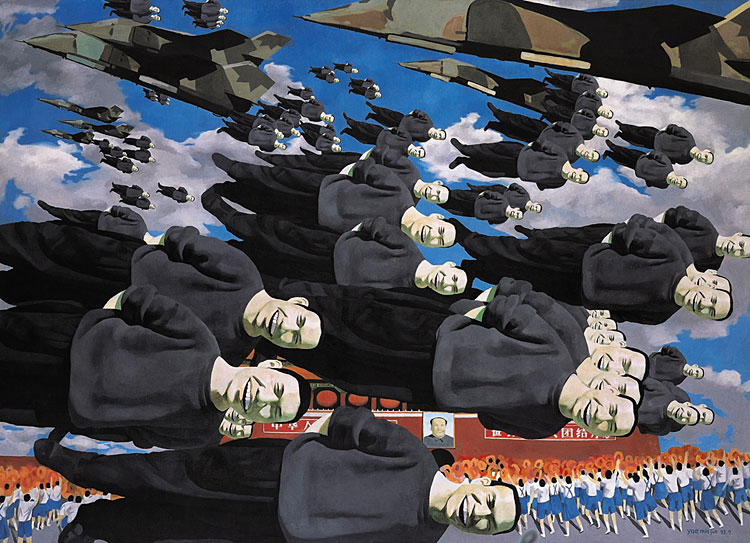
E.C: Democritus, the Greek philosopher belonging to the pre-Socratic school of thought, was known as the "philosopher who laughs", owing to his knowledge that reality cannot be reversed and that laughter is the best tool we have to help us cope in life. On the one hand, this represents an accepting of our reality, thereby stripping it of all seriousness. On the other, however, this serves to help us make sense of our own existence.
Do you believe that man should use this as a weapon against the unintelligible nature of our existence?
Y.M: The laughter could be a perfect marriage with feeelings. If we have the capacity to smile throughout adversity, then our presence will become stronger, tolerant and diverse, both for the artistic culture and for the majority.
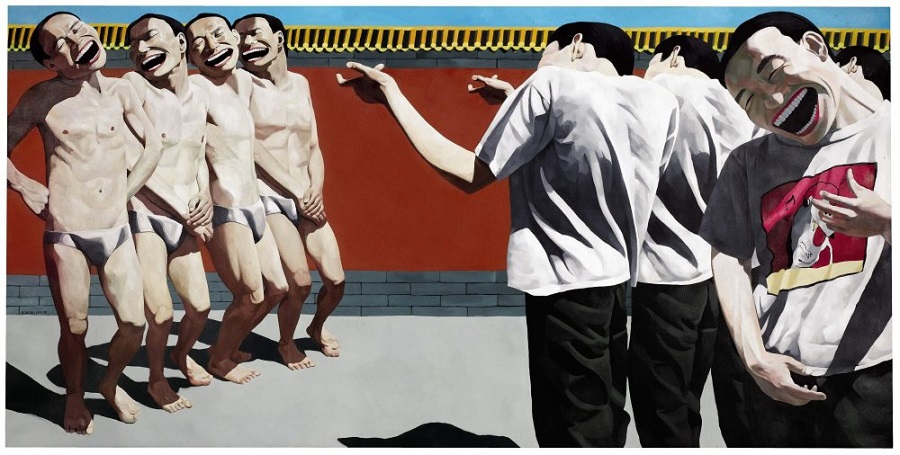
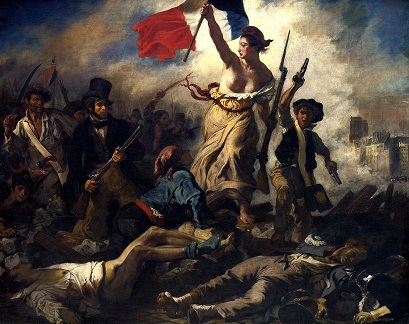
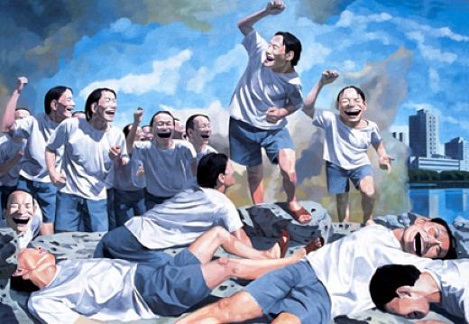
E.C: Some of Minjun's works use icons in reference to key works throughout the history of art, including Liberty Leading the People by Eugene Delacroix, The Third of May 1808 by Francisco de Goya, and the Execution of Emperor Maximilian by Manet, inspired by the Tiananmen protests.
To what extent has your work been influenced by Western painting? Does the laughter in your work represent any negativity or criticism?
Y.M: The influence was very big in the 80's, thanks to the reform and the opening up of China, it came to us with the impact of a variety of foreign cultures. At that time, I was studying painting and I had the opportunity to be in touch with these works, which is why external influences were so relevant to my artistic creation. In my evolving expression there is an important part of my old work that is evocative of realism, which, at the same time, examined important questions such as the revolution, social reforms, definitely, as well as passion for life. And then I was getting to know artists like Picasso, and I was approaching Western painting while reflecting on visual evolution.
I think representation like that, in a more popular and simple way, my works will generate a more comprehensive meaning, both for the Chinese and the Western viewer.
E.C: Do you use laughter as a tool for criticism in your work?
Y.M: Yes, that's right. That's why I choose to paint laughter, to comunicate a sense of pleasure and happiness, but actually, it hides a double perspective of drama and suffering.
E.C: What are your sources of inspiration and where does your aesthetic come from?
Y.M: Actually, my Western influences have not come in the form of aesthetics or techniques, but rather in the form of iconography. Ancient Western painters knew and used this form of enlightenment in their painting, which also have many different interpretations between the West and China. Therefore, I have also practised the use of iconography to portray the interpretation of what I actually want to express.
Regarding the aesthetics and techniques used in my work, one can appreciate a ceratin simplicity, referencing my training at University. A good example is my teacher, who graduated from the Central Academy of Fine Arts of China, learning the techniques of realism from the former Soviet Union, and France at that time. He also learned how to observe objects while influenced by Impressionism; he painted lights and shadows, etc. However, I make use of the techniques I learned through my work, no longer portraying spontaneity or thoughtlessness.
During the formation of my aesthetic style, beginning with my own feeling or point of view, I thought my work should be as simple as possible, without any handling; completely removing sophistication without altering the initial result. Actually, I claim that my work is directly perceptible, beautiful and candid, with bright colours in order to attract the immediate interest of the viewer.
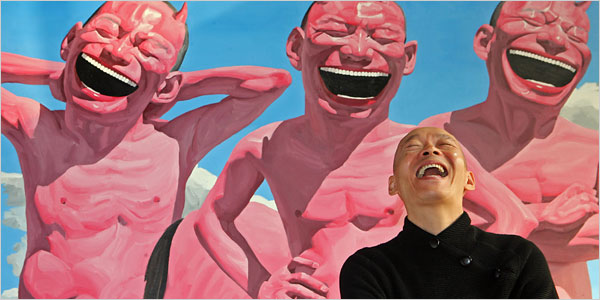
E.C: At times you have said that each of your works are based on your feelings and experiences, and that you are by nature a pessimist.
Where does this pessimism come from and what has it led to?
Y.M: My pessimism comes from the sad desperation that I feel when I observe my own culture. I mean, the society that surrounds me, their way of life and my own.
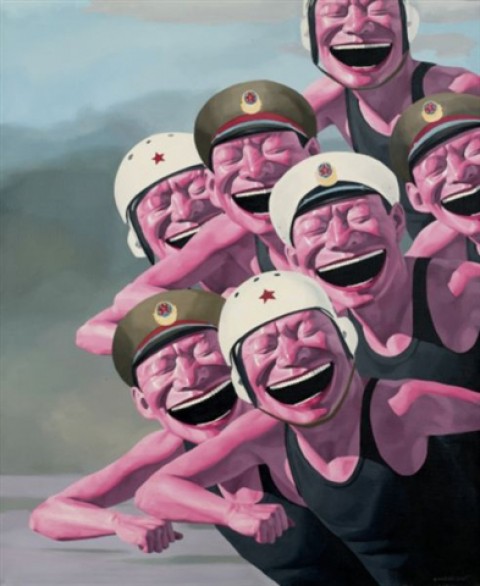
E.C: Your works contain allusions to Communist iconography, to a consumer society or to historical moments, at the same time loaded with conceptualism. Tragedy and comedy are cleverly mixed in such a way that it makes it difficult for us to determine our feelings about what we are seeing.
How do you hope the public will approach your work?
Y.M: The direction of my work is allegorical between human nature and our own existence. Because I have noticed that, not only in the East or in China, people are constantly facing emotional conflict.
I want to show how the individual, through painting, must remain awake, and how we need a greater understanding of the basic concepts of nature and life itself.
My work dosen't try to overly dramatise, and not because of that absence of tragedy. I want to refer to what each person feels by their sorroundings, or to the past experience that has been left in them through materialism; this does not liberate the human spirit, it is a pressure that leads to slavery.
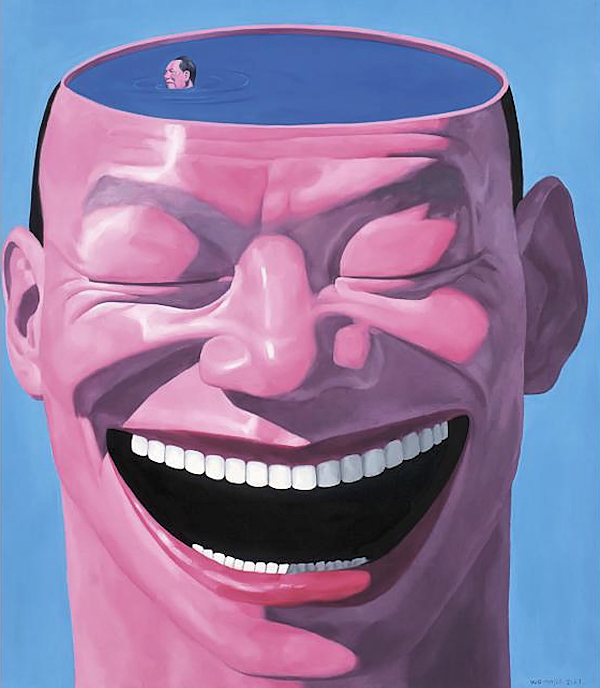
E.C: In 2007, Minjun's painting Execution became the most expensive piece of work ever produced by a Chinese artist. And last year, Cartier's Foundation for Contemporary Art held the biggest ever tribute to a Chinese artist in Europe, exhibiting almost 40 pieces of your work.
What has this international recognition and commercial success meant to you?
Y.M: For me, the social repercussions that my work had and the spread of them in the country where I live, has been very important because that generated my personal growth and my artistic recognition.
I'm glad to know that the majority of my work is recognised by a lot of people, and that contributed to the reflection and comprehension in the way the artist is used to comunicate with society.
E.C: What is the future of your painting?
Y.M: There have been major changes to my creation. Given the different influences during my life, such as the Cultural Revolution or the time of the reform and opening. Actually, the 80s onwards have been an important period, as an era of great social change.
Of course, these changes refer, in most part, to the growth of materialism. Afterwards, I became more interested in discovering the origin of laughter in my work. Why are you laughing? Why is there this expression of laughter? I have come to understand that it is my own traditional culture. As a result of my reflection on laughter, I have related many of my works to the maze, which is integral to traditional culture; trying to express a feeling of confusion, loss and internal questioning that is in harmony with pain.
"Man alone suffers so deeply that he had to invent laughter" - Nietszche.
- Página principal: Alejandra de Argos -

